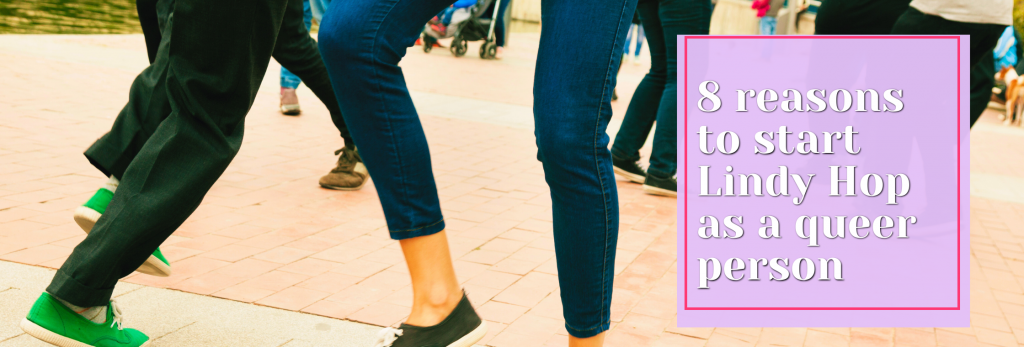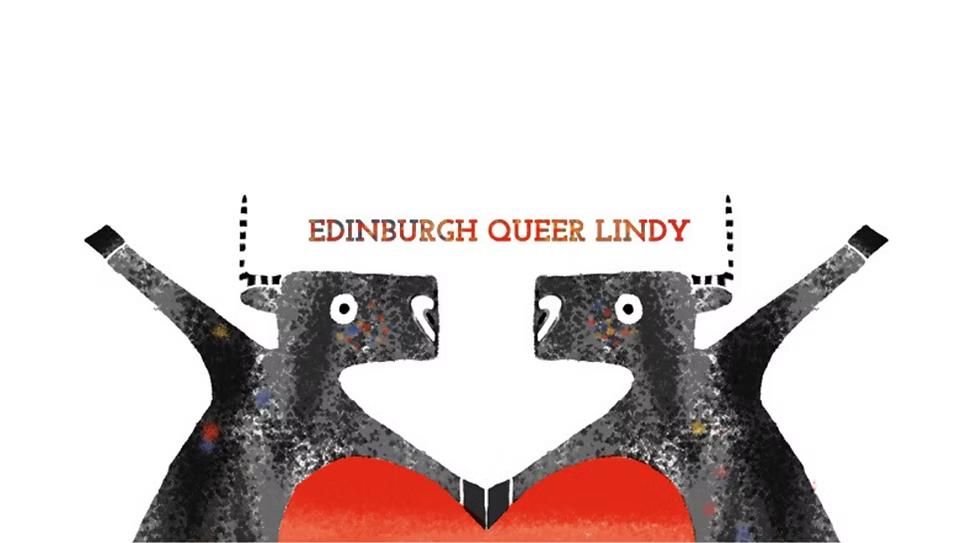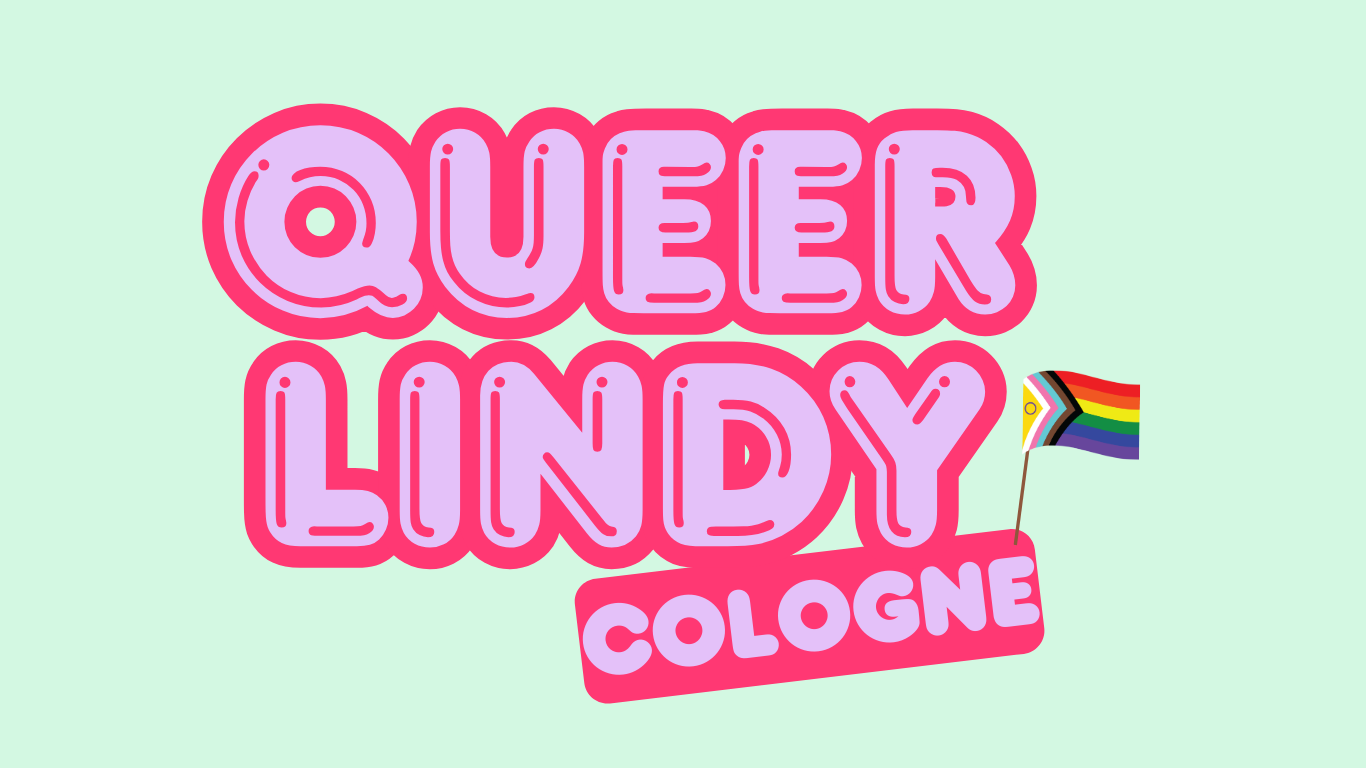
Discover the Joy: 8 Compelling Reasons Queer Dancers Should Start Dancing Lindy Hop
No matter what part of the alphabet mafia you identify as – lesbian, gay, bisexual, trans, non-binary, genderqueer, or any other wonderful identity within our community – Lindy Hop might just be right for you.
We here at Queer Lindy Cologne want to help you become a part of our dance scene. We do realise, though, that a lot of you might have no idea what (queer) Lindy Hop is, or you might have just ended up here by googling “good dance for queer people” – you have not (yet) been infected with the Swing virus. No worries, we’re here to make sure you soon will be! If you are queer and would like to start dancing, Lindy Hop could be just what you are looking for.
Check out the 8 reasons why we think you should start Lindy Hop as a queer person.

1) Easy way to make new friends.
First of all, Lindy Hop is a great way to meet new people. Unlike other dances, most Swing classes have adopted a policy of constant partner changing: you will rarely be with the same person for more than two minutes. (No worries – with all this partner changing, asking for someone’s name again, even
though you have danced with them multiple times before is not frowned upon. We’ve all been there.) We have all made great friends because of a fantastic dance we had with someone and then decided we wanted to get to know them better.
Moreover, social dances, i.e. parties with DJs or live Swing music where you can dance with others, offer lots of opportunities to meet new people. And while quite a few events tend to happen at night, there is a variety of events on offer if that is not your cup of tea. Here in Cologne alone, you can find e.g. Tea Dances on Sunday afternoon or a weekly dance in the park by the Rhine during spring and summer.
If you are interested in events that are specifically made by and for queer people, check out our events page.
2) Challenge gender norms.
Like most places in society, Lindy Hop is still highly gendered, e.g. with regard to dance roles and outfits. BUT.
The Swing scene has taken great strides in the last decade to move away from gendered language. It is very rare to be in a class setting and hear the teacher use gendered pronouns for the different dance roles. Competition types that previously had gendered names (“Jack & Jill”) are now referred to by gender-neutral names (“Mix & Match”). The willingness of the Lindy Hop community makes us think that more progress is possible.
For most dancers, despite the non-gendered language, the default expectation is still that women follow and men lead. Obviously, traditional gender roles and partnerships in dance rarely align with queer identities and realities. While at most Lindy events, you will still see people dance in the role traditionally associated with their gender, this is also slowly changing. It is not rare to see women take on the leading role; it is, admittedly, still a lot rarer to see male-presenting dancers follow. But things are changing. Plus, more and more dancers are switches: they will change roles mid-dance. Is there anything queerer than that? (Apart from Katie Cobalt’s and Jason Hsu’s wonderfully queer drag performance you can see on the left, of course.)
Now, we cannot promise that you won’t ever have a dance with someone that is still stuck on gender roles. But luckily, the constant partner changing will mean you can complain about it to your next dance partner right away – and if this is something that enrages you: welcome, you’ve come to the right place.
3) It is rooted in a vibrant culture influenced by queer identities.
Lindy Hop was pioneered by African Americans in the 1930s in Harlem. This period, which is called the Harlem Renaissance, has been characterised by a literary critic and professor as “surely as gay as it was Black, not that it was exclusively either of these“.
There are lots of prominent examples of queer people at the time: take for example Gladys Bentley, an entertainer and singer known for wearing men’s clothing; take Ma Rainey, who hosted a lesbian party and sang about same-sex attraction in a song (“I went out last night with a crowd of my friends / It must’ve been women, ‘cause I don’t like no men”); or take Billy Strayhorn, the Robin to Duke Ellington’s Batman, who was openly gay to his friends and his band members.
We have written a blog post on queer dancing during the Harlem Renaissance here. Queer Swing Seattle has comprised a list of queer influences on Lindy from the past, and you can also find podcasts about queer Lindy Hop history on our resources page. For more information on the queer history of the Harlem Renaissance, we recommend this article from the National Museum of African American History and Culture and this overview by the New York Times.

4) Lindy Hop as a way to explore our identity
Ask anyone who’s been dancing for a while and they will tell you that dancing Lindy Hop is a great means of expressing who you are. Jazz music is a highly free, fluid and versatile genre that encourages us to improvise and move to whatever it offers us – in our own personal ways. There is not one way of dancing a swingout, of styling your jig walks; there isn’t just one way to swivel.
You want to move in a particularly masculine or feminine way and dance in a highly gendered way? Go for it! You want to take up space and celebrate who you are? Dance big! You want to follow but very much do not want to simply do whatever is suggested to you? Then be an active follower, initiate moves and break off from your partner in the middle of the dance to show off your Solo Jazz skills!
If the music and the dance are so versatile, it only seems logical to say that Lindy Hop provides a great platform for us to express our queerness. How we choose to do that, on the other hand, is completely up to us – maybe you do so by challenging disregarding gender norms, or by switch dancing. We here at Queer Lindy Cologne are trying to figure this out for ourselves as well, and are also actively working on making sure there are more queer people in this community aiming for the same thing.
5) There’s an international community

Once you really get infected by the Lindy virus, you’ll want to visit other cities and places to dance. Festivals are a great chance to take classes with new teachers and be inspired by dancers you have never danced with before. They can also focus on different aspects of dancing, or be geared towards a specific group of dancers.
In Europe, there are already two established queer Lindy Hop festivals in Edinburgh and in Gothenburg – and they are absolutely brilliant. They are one of the reasons we started to create something here in Cologne, too! And who knows, maybe there will be one in Cologne soon enough…
6) Great for your mental well-being
A dance with someone can be a great way to share experiences. It allows us to understand different perspectives and learn from each other. In Lindy Hop, a great dance is all about communication without needing to have an actual conversation about what move to do when. You listen to the music and your partner, inspire yourselves and react to one another.
You see the way your partner moves their hips, you join them in their movement and add a little shimmy, which your partner then takes on and builds on it. This give-and-take can be a very fulfilling experience; even if you do not actually know each other well, it helps us feel seen and valued.
And if you do not feel up for any interactions, you can always share space on the dancefloor with others and dance Solo Jazz by yourself, next to others.
7) While the scene is by no means perfect – it’s not terrible either.
If you listen to interviews with queer Lindy Hop dancers, a lot of them will (rightly) criticise the general Swing community, e.g. for its lack of diversity at the higher levels or its heteronormativity in places. Nevertheless, a lot of us continued with the dance after an initial taster precisely because it seemed more liberal and progressive than we had first expected. It does feel novel and liberating to not hear gendered language in a dance class when that’s what you’re used to. It is a lovely surprise to change partner in class and suddenly find that the person who, at a first glance, you thought would absolutely hate dancing with you turns out to be a great partner who you really vibe with.
Some events and dance schools have taken measures to make their spaces more welcoming and safe. This includes consulting with and being guided by people from marginalised groups to create environments that are genuinely inclusive. At some events, you will find safety officers: people you can go to if you feel unsafe in any way, who try and make sure the code of conduct of the event is adhered to by everyone.
Sometimes you get bogged down – maybe you were at a social dance where it was difficult to dance in the role not traditionally assigned to your gender, maybe you had a weird experience during a dance, maybe there was an odd, lingering look. These experiences do happen, and they suck. But all of us argue that the positive experiences far outnumber the negative ones. Why not be part of making this scene a better one and join us?
8) It’s so much fun.
This is what it ultimately comes down to: if you ask any of us for the number one reason we dance Lindy Hop, it is because it has given us so much joy. This might be because of friends you’re having a connection with on a dance floor, because you felt seen, because you were able to express yourself in a way that felt very ‘you’ or because you decided to be playful in your dance with someone who was 100% on board.
What we are trying to say: come by, get a taste of (queer) Lindy Hop (maybe at one of our events), and start dancing! And if you still need convincing, join us at one of our Queer meet-ups before social dances and we will happily persuade you in person.
Do you think we’ve missed a reason or we got something wrong? Get in touch with us on our Instagram account or contact us via email.
